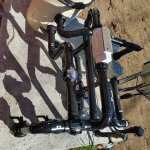- Nov 12, 2017
- 12,682
- Pool Size
- 12300
- Surface
- Plaster
- Chlorine
- Salt Water Generator
- SWG Type
- Pentair Intellichlor IC-40
Hanging off the pad like that, even though it isn't an actual problem, would drive me crazy.
But here would be my real issue, though unfortunately it might be impossible to prove. The reason the installation instructions call for a straight run of pipe before the cell is to minimize turbulence against the flow switch, which is just inside the inlet. If there is too much turbulence, the flow switch could disallow the cell to work. The work-around for that is to in crease the pump RPMs, so that the water pressure sort of overcomes the turbulence problem and pushes hard enough on the flow switch to allow the cell to work. The elbow right before your SWG is going to cause some amount of turbulence on your flow switch.
That doesn't "hurt" the cell. They can work with higher flow rates, no problem. The problem is: it's generally the SWG that drives your runtime. Instead of a few hours of runtime, to keep your water filtered, the SWG now needs many, many hours (8? 10? 12? or more) to produce the chlorine you'll need. So you want to be able to run your pump as slow as possible to keep your energy costs down. If you have to goose your pump RPM to satisfy your SWG, just because it was not installed correctly, well, that's a waste of energy. How much is hard to say, but whatever it is, that waste will be occurring X hours a day, every day, forever.
I think it is @Jimrahbe that claims he can run his pump at 1200 RPM to keep his SWG happy. I have to run mine at 1500 RPM. I think we have the same SWG. But mine "costs me" 300RPM more than Jim's to run, eight hours a day, every day, for nine months out of the year! So that might be because of the way he and I have are SWGs plumbed. That adds up, and electricity ain't getting any cheaper!
By rights, you could ask them to do it again, correctly, because the installation instructions are very clear on this point. And @ajw22 is right, they've already built in to your pad enough potential future problems, so they can at least eliminate this one.

But here would be my real issue, though unfortunately it might be impossible to prove. The reason the installation instructions call for a straight run of pipe before the cell is to minimize turbulence against the flow switch, which is just inside the inlet. If there is too much turbulence, the flow switch could disallow the cell to work. The work-around for that is to in crease the pump RPMs, so that the water pressure sort of overcomes the turbulence problem and pushes hard enough on the flow switch to allow the cell to work. The elbow right before your SWG is going to cause some amount of turbulence on your flow switch.
That doesn't "hurt" the cell. They can work with higher flow rates, no problem. The problem is: it's generally the SWG that drives your runtime. Instead of a few hours of runtime, to keep your water filtered, the SWG now needs many, many hours (8? 10? 12? or more) to produce the chlorine you'll need. So you want to be able to run your pump as slow as possible to keep your energy costs down. If you have to goose your pump RPM to satisfy your SWG, just because it was not installed correctly, well, that's a waste of energy. How much is hard to say, but whatever it is, that waste will be occurring X hours a day, every day, forever.
I think it is @Jimrahbe that claims he can run his pump at 1200 RPM to keep his SWG happy. I have to run mine at 1500 RPM. I think we have the same SWG. But mine "costs me" 300RPM more than Jim's to run, eight hours a day, every day, for nine months out of the year! So that might be because of the way he and I have are SWGs plumbed. That adds up, and electricity ain't getting any cheaper!
By rights, you could ask them to do it again, correctly, because the installation instructions are very clear on this point. And @ajw22 is right, they've already built in to your pad enough potential future problems, so they can at least eliminate this one.

Last edited:



